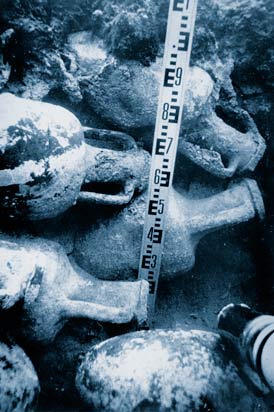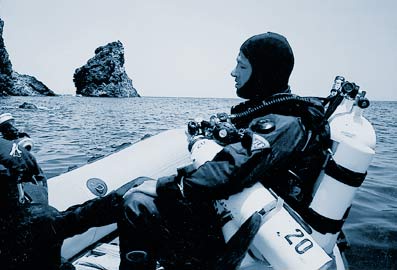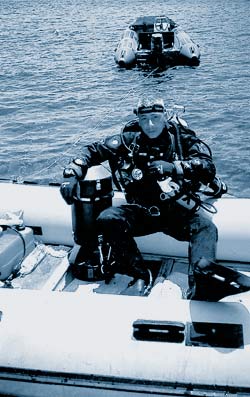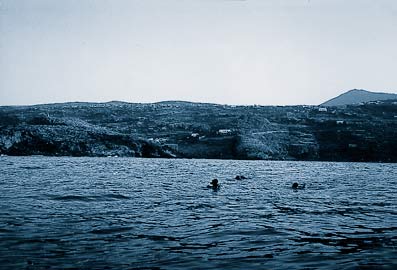DIR Divers in Archaeological Research
DIR Divers in Archaeological Research
BY MARIO ARENA & PAOLO PASSALACQUA
 |
|
Roman Amphorae
|
From the dawn of Western civilization until roughly the 15th century, the Mediterranean Sea acted as a cradle for many a budding culture; it was the center of trading, of exploration, of colonization, of many wars and battles. Over the years, ships of various shapes and sizes wandered around this sea, by sail or by oars, carrying a variety of goods to a variety of ports. As fate would have it, some of them were lost to the sea, victims of different kinds of forces.
Wrecks of ancient vessels are not typical sites of exploration for recreational divers. They are often restricted access zones, sites where underwater and naval archaeologists carry out research aimed at understanding the life and practices of those who came before us. Historical researchers are justified in being suspicious of recreational divers. Theft, the careless destruction of cultural artifacts, as well as the danger posed by unskilled and uneducated divers to the integrity of unexplored sites, where every object and its relative position in the site has a decisive importance to the result of archaeological research, have greatly contributed to a feeling of distrust among researchers. Nonetheless, only a minority of divers is responsible for this reigning climate among researchers.
Cooperating with researchers might help overcome this distrust; it might also bring about a period of collaboration between different organizations in projects that promote and conduct underwater exploration and archaeological research.
Researchers would benefit greatly from experienced and properly trained divers. Having such divers available for exploration, for survey and for light recovery from sites deeper than 50 meters, allows researchers, for the first time, a unique kind of access to deep and still untouched sites; it also gives them access to a plethora of data, provided by divers, that could never be obtained through machine observation.
 |
|
Paulo Passalacqua
|
This is how the collaboration between Italian Authorities of the Departments of Cultural Arts of Trapani and the Wreck Diving Society (WDS) of Trieste was born. Following a specific request by this Department, a GUE diving team performed a series of exploration dives along the coasts of Pantelleria in the middle of the Sicily Channel. The aim of these dives was to verify the existence of an ancient Roman wreck. Authorities had been notified that amphorae were present at the base of the walls in Punta Spadillo. Previous exploration, involving an ROV, had located two amphorae at a depth of 93 meters (300 feet). However, the ROV soon proved inadequate for this task because of strong currents, limited camera field of vision and difficulties in following a pre-organized and schematic research path. According to the researchers themselves, having divers on the seabed is a far better way to investigate and check sites; compared to the usual methods, unbelievable results can be obtained.
Those responsible for the logistical organization of the dives had to face the island's characteristic difficulties: they had to provide for appropriate gas mixes, account for distances to assistance centers and so on. All the required gases and equipment had to be brought to the island. Among its equipment, the team had: a total of 12 twins (18+18 lt), numerous decompression bottles (50% and Oxygen), Gavin scooters, a digital video camera, and a portable hyperbaric multi-lock chamber GSE (Giunio Santi Engineering). The explored area is distinguished by a jagged volcanic morphology; it is subject to violent hydrodynamic conditions, characterized by very strong currents. The four dives were conducted from two inflatable boats in heavy seas (force 4-5), with 6-8 foot waves from the northwest, and a strong current, probably the same conditions that caused the sinking of the Roman vessel about 2,000 years ago.
 |
|
Mario Arena
|
The team was composed of Mario Arena, Paolo Passalacqua, and Leonardo Luca Laneve as underwater cameraman.
During research operations, an area of approximately 300 meters (285 yards) close to Punta Spadillo was thoroughly explored between the barometrics of 66 meters (220 feet) and 102 meters (340 feet).
More than 60 amphorae were located in 6 different groups at depths ranging from 69 meters (230 feet) to 90 meters (300 feet). Experts identified three different kinds of amphorae; two of them were Punic-featured and one Roman. They were dated back to the first or even second century B.C., and were believed to be part of the cargo of the same wreck; this is because all three kinds of amphorae were present in each of the research sites.
Most of the four-hour surface intervals between dives were used for debriefing with archeologists and for planning the best search patterns and the most important tasks of the following dive.
All the relevant phases of the exploration and the search were recorded on digital video, while each object found was thoroughly photographed for use in a comprehensive report to archeological experts.
One entire dive was spent joining the findings with cave line in order to produce a better perspective of the relative positions of the various spots. When this was completed, an area 50 meters wide with a depth varying from 69 to 91 meters was created, one that seemed to enclose the remains of the entire shipwreck.
Due to the jagged sea bottom and the limited number of dives that could be performed, we could locate neither the main part of the cargoÑmaybe many hundreds of amphoraeÑnor the shipwreck.
Further exploration is planned for the future, even though archeologists have declared that they do not intend to remove the remains of the shipwreck. They prefer to conduct subsequent research of the site, and leave the care and access control of the site to a local dive shop, which will take care that only experienced divers access it.
WDS divers, who were accustomed to decompressing along an ascent line, spent their 40/50 minutes of deco time on a very interesting journey, scootering back to the starting pier almost a quarter of a mile away; as they wandered between the reefs and clouds of fishes in very clear and warm water, they carried out one of the funniest decompressions ever.
 |
|
At the Divesite
|
Mario Arena and Paolo Passalacqua are active members of the Wreck Diving Society (WDS) of Trieste. Paolo was the first Italian diver to be both GUE Tech and GUE Cave certified. When he returned to Italy he helped organize DIR Italia to promote DIR diving in Italy.

